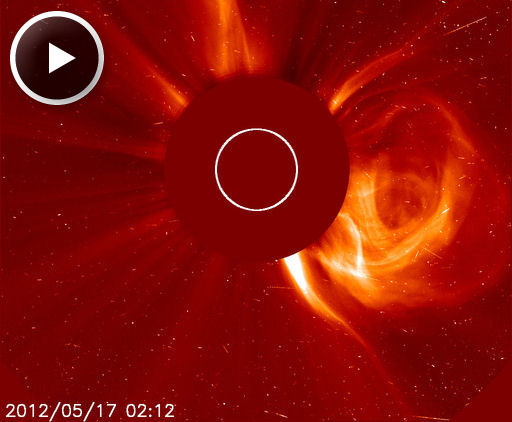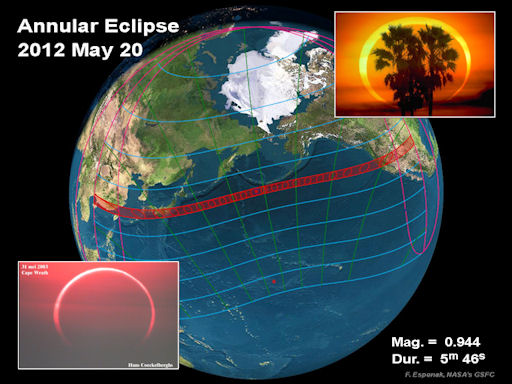Listen to radar echoes from satellites and meteors, live on listener-supported Space Weather Radio. | | |
4700 DANGEROUS SPACE ROCKS: NASA has just released a new count of asteroids that come close to the orbit of Earth and could survive entry through our planet's atmosphere. Using an infrared space telescope to track even the darkest space rocks, researchers say there are 4700 +/- 1500 potentially hazardous asteroids. [full story]
RADIATION STORM: A radiation storm around Earth is subsiding. The storm began during the early hours of May 17th when a strong M5-class flre accelerated a fusillade of solar protons in our direction. At its peak, the S2-class storm was capable of confusing spacecraft imaging systems and causing 'single event upsets' in orbiting electronics. Radiation storm alerts: text, phone.
The explosion that caused the radiation storm also hurled a coronal mass ejection (CME) into space. SOHO recorded the cloud racing away from the sun faster than 1500 km/s:

The speckles in the movie are caused by energetic protons hitting the observatory's detector. This kind of "snow" is a sign that a radiation storm is underway.
This CME is not heading for Earth. It will, however, deliver a glancing blow to Mercury. According to a forecast track prepared by analysts at the Goddard Space Weather Lab, the cloud will reach the innermost planet on May 17th at 15:09 UT (+/- 7 hr).
SOLAR ECLIPSE THIS WEEKEND: On Sunday, May 20th, the Moon will pass in front of the Sun, producing an annular solar eclipse visible across the Pacific side of Earth. The path of annularity, where the sun will appear to be a "ring of fire," stretches from China and Japan to the middle of North America:

An animated eclipse map prepared by Larry Koehn of ShadowandSubstance.com shows the best times to look. In the United States, the eclipse begins at 5:30 pm PDT and lasts for two hours. Around 6:30 pm PDT, the afternoon sun will become a luminous ring in places such as Medford, Oregon; Chico, California; Reno, Nevada; St. George, Utah; Albuquerque, New Mexico, and Lubbock, Texas. Outside the narrow center line, the eclipse will be partial. Observers almost everywhere west of the Mississippi will see a crescent-shaped sun as the Moon passes by off-center.
Because this is not a total eclipse, some portion of the sun will always be exposed. To prevent eye damage, use eclipse glasses, a safely-filtered telescope, or a solar projector to observe the eclipse. You can make a handy solar projector by criss-crossing your fingers waffle-style. Rays of light beaming through the gaps will have the same shape as the eclipsed sun. Or look on the ground beneath leafy trees for crescent-shaped sunbeams and rings of light. [full story] [video]
Potentially Hazardous Asteroids (
PHAs) are space rocks larger than approximately 100m that can come closer to Earth than 0.05 AU. None of the known PHAs is on a collision course with our planet, although astronomers are finding
new ones all the time.
On May 17, 2012 there were 1287 potentially hazardous asteroids.
Notes: LD means "Lunar Distance." 1 LD = 384,401 km, the distance between Earth and the Moon. 1 LD also equals 0.00256 AU. MAG is the visual magnitude of the asteroid on the date of closest approach. | | The official U.S. government space weather bureau |
| | The first place to look for information about sundogs, pillars, rainbows and related phenomena. |
| | Researchers call it a "Hubble for the sun." SDO is the most advanced solar observatory ever. |
| | 3D views of the sun from NASA's Solar and Terrestrial Relations Observatory |
| | Realtime and archival images of the Sun from SOHO. |
| | from the NOAA Space Environment Center |
| | the underlying science of space weather |

